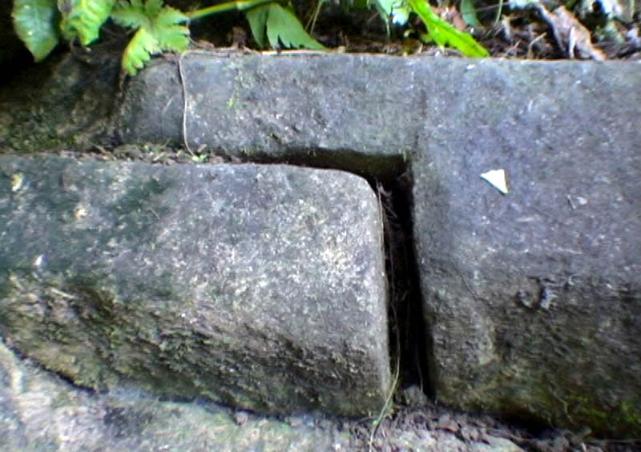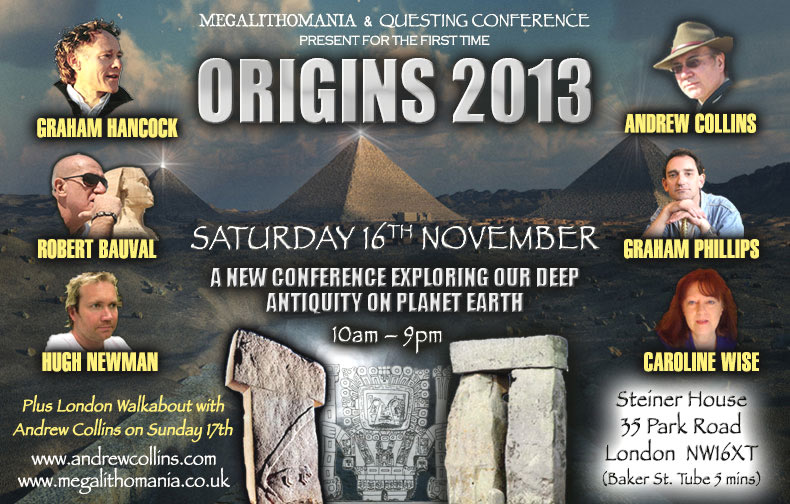![]()
Andrew
Collins Newsletter - September 21, 2013

Andrew
at Harran in southeast Turkey, with the
city's famous Astronomical Tower in
the background.
London, September 21, 2013. I returned yesterday from the Origins of Civilization tour of Turkey, which across a period of twelve days visited Göbekli Tepe (twice), Catal Hoyuk, Asikli Hoyuk; the rock churches of Cappadocia; the underground city of Derinkiyu; the ancient city of Konya, where we saw the Whirling Dervishers perform their sublime sufi dance ritual; the ruins of Troy, scene of the Trojan War of Homer's Iliad, the Hittite complexes of Hattusha and Alaca Hoyuk, both of which contain cyclopean polygonal walls like those in Peru and Easter Island, as well as the Blue Mosque and Hagia Sophia in Istanbul.
As you can imagine doing all this has been a complete mind-blowing experience. Add into the mix the fact that we were joined by Graham Hancock, who delivered no less than five audio-visual presentations on everything from the Ark of the Covenent to Ayahuasca, Göbekli Tepe and the destruction of the Aztec Empire (subject of his recent fictional work “War God”), and you can understand why my head is still spinning.
SOUL
HOLE DISCOVERY
All this is before mentioning that whilst at Göbekli Tepe, in the company of many of the tour participants, I made an extraordinary discovery that greatly enhances the theory that the site's main enclosures are oriented north and not south towards a stellar target such as Sirius or Orion.
I had already noted there is a holed stone, on which is an abstract representation of a human female's torso and legs (the hole forming her vulva) in the NNW section of Enclosure D's perimeter wall, exactly in line with the alignment of its twin central pillars. This would have allowed someone - a priest or shaman perhaps - to stand between the two great stones and watch the setting of Deneb and the Milky Way’s Dark Rift on the NNW horizon.
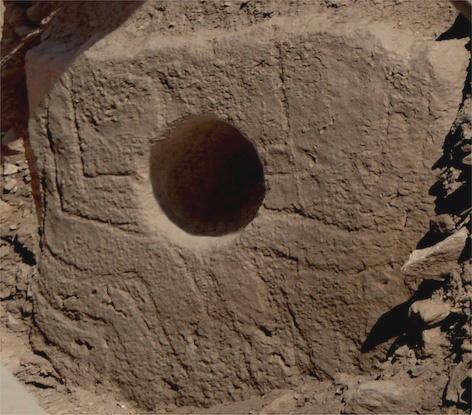 |  |
Left, the holed stone with abstract female form in Göbekli Tepe's Enclosure D, and, right, the holed stone in Enclosure C, which is broken and on its side.
Yet on our tour's second visit to Göbekli Tepe on September 17th I was examining Enclosure C, situated immediately SE of Enclosure D, and discovered, half buried in earth and debris in front of the NNW section of its outer perimeter wall, a similar holed stone. It is on its side, having been turned over on it western edge by the force of the earthen mound bearing down on it. It is broken across its circular hole, which is 11-12 inches in diameter (the one in the holed stone in Enclosure D is around 7-8 inches in size). When re-erected it would have stood exactly in line with the twin central pillars, as per the one in Enclosure D.
I have not noted this holed stone mentioned in any publication on Göbekli Tepe, and so it was a complete surprise to me upon its discovery. Whether it has any decoration on its still buried side, and its missing section awaits discovery nearby, remains to be seen.
Its presence shows that Göbekli Tepe's two largest known enclosures, Enclosures C & D, both have holed stones in the NNW, which during the epoch of their construction. c. 9400-8900 BC, targeted Deneb and the Milky Way's Dark Rift. This, as you know from "The Cygnus Mystery" (2006), and will see again in new book “Göbekli Tepe: Genesis of the Gods”, has been seen as an entrance and exit to the sky-world among ancient cultures for many thousands of years.
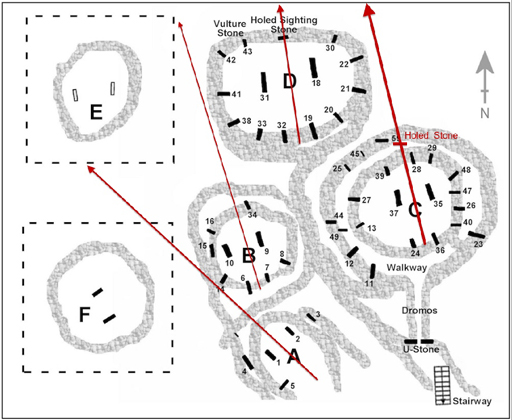 | 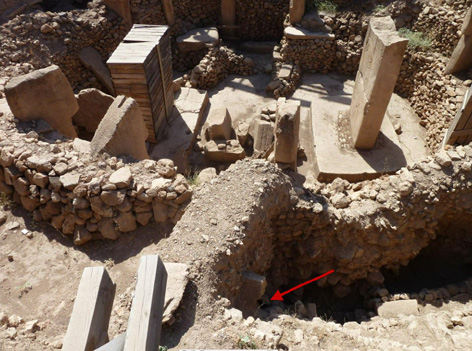 |
Left, the principal alignments of the main enclosures at Göbekli Tepe,with the positions of the holed stones shown in Enclosures C & D, and, right, the location of the holed stone in Enclosure C.
So what are these holed stones? The answer is they are probably what is known in Germany as Seelenlöcher, "soul holes", openings through which the soul of a deceased person can escape. They feature in ancient burial customs across Europe, particularly in Germany and Switzerland, where "tiny windows" would actually be made in the wall of a cabin in order for the deceased's soul to more easily escape its physical surroundings.
Soul holes are also found occasionally in ceramic burial urns, particularly in Anatolia (i.e. Turkey), and most importantly they are often found in the blocking stones of megalithic dolmens, chambered tombs, and passage graves, which date back many thousands of years. These are to be seen in Belgium and Germany, as well as in the Caucasus region of Georgia, the same region of the globe as Göbekli Tepe.
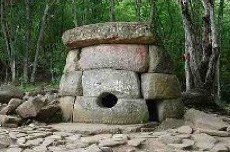 | 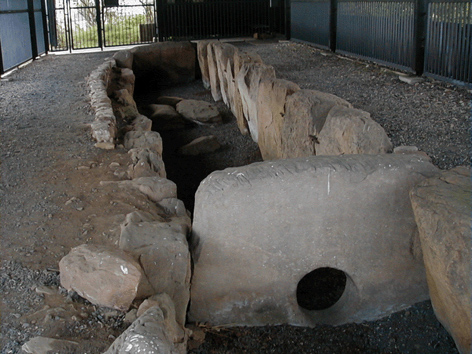 |
Left, a dolemn in the Caucasus region of Georgia, and, right, the Züschen chambered tomb at Hesse, Germany, both showing soul holes, probably for the passage of the soul departing or returning to its physical environment.
Usually these stone-cut holes are circular, oval or occasionally square in shape (indeed, the light box above the entrance to Newgrange’s passage grave in Ireland’s Boyne Valley might well be a soul hole). Often they are too small for a person to crawl through, showing they probably have some symbolic or ritual function. This was either to allow the passage of the soul, or souls, of those interred in the structures to leave their surroundings, or to enable the entry of incoming light from a celestial body, most obviously that of the sun, moon, or a planet such as Venus. Their alignment to stars is more speculative, but is certainly not out of the question.
Significantly, Professor Klaus Schmidt, the lead archaeologist at Göbekli Tepe, believes that stone rings found at Göbekli Tepe, which are up to half a metre in diameter, might once have stood within the walls of enclosures, and perhaps acted as Seelenlöcher, allowing the souls of the deceased the right of passage to the next world. So connecting the holed stones in Enclosures C and D with Seelenlöcher is by no means outrageous.
So if the holed stones in Enclosures C and D did indeed have a symbolic or ritual function, then perhaps they acted as portals or port-holes for the entrance and/or exit of souls, whether of the living or deceased, passing back and forth between the enclosures and perceived otherworldly locations. In doing so, they define the monument's direction of orientation, which we find is towards the north, and not the south.
This amazing discovery, made on the Megalithomania Origins of Civilisation Tour, was recorded on video by some of the guests, and hopefully in the future the results can be posted online. Just shows you what can happen on important trips like these.
HAWASS
TALKS ON GIZA CAVES
"What exactly is the system of recently discovered underground caves and rooms underneath the Giza Pyramids? Are there any secret chambers?"
These are the questions Zahi Hawass will ask in an online conference streamed live across the net on September 29th.
That "system of recently discovered underground caves" is the one found by Nigel Simpson and myself in 2008 following a five-year investigation of old accounts by European travellers and explorers, such as Henry Salt, Giovanni Caviglia and Howard Vyse. The same cave system that Zahi initially denied existed in 2009, but was then seen the following year careering through in TV reality show "Chasing Mummies", calling this his best ever experience at Giza.
The system that in 2009 he called "Collins cave".
I suspect that in his online presentation Zahi will reveal the findings of his investigations of the cave and its entrance - the tomb NC2, aka the "Tomb of the Birds" in Giza's north cliff, located northwest of the pyramid field's western cemetery. These excavations took place before the site was gated and secured in 2010 in order to preserve its priceless archaeology.
If anyone records this online conference, please upload it to YouTube and share the link.
I
actually like Zahi Hawass. He is the Pantomine Dame of the Egyptological world,
and I have no problem with him promoting the caves. At least he acknowledges they
were "recently discovered", which means he accepts they were previously
unrecorded before Nigel Skinner Simpson and myself entered them in 2008. I think it is important to remember that without Zahi Hawass none of the explorations of the Sphinx Enclosure over the past two decades could have taken place. He works very closely with the Edgar Cayce Foundation and Association for Research and Enlightenment (ARE), with whom he has close personal ties and affiliations. He even believes that a lost Secret Chamber might well exist at Giza. |  Dr Zahi Hawass (Pic credit: Andrew Collins) |
On
April 4-6th, 2014, Zahi will be at the ARE headquarters in Virginia Beach, VA,
taking part in a conference that will essentially revolve around him and his work.
I suspect he will heavily feature the caves, especially as he is talking about
them on September 29th.
For
a full account of the caves’ discovery see my book “Beneath
the Pyramids” (2009).
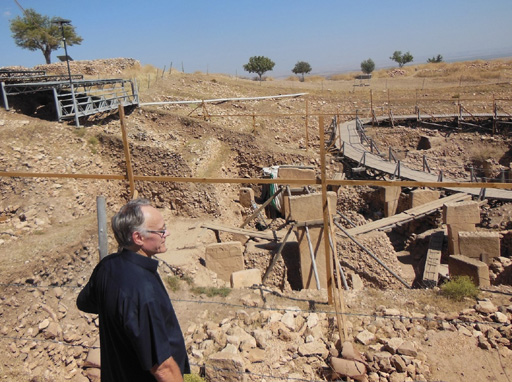 Graham Hancock at Göbekli Tepe, September 16th, 2013. | A NEW BEGINNING Graham Hancock did a lecture on the tour outlining the thrust of his new book “Magicians of the Gods”, which is published in 2015. It will show that Göbekli Tepe provides ample evidence that we need to re-assess the dating of megalithic structures worldwide. Moreover, it is evidence that a previous civilization, which navigated the high seas, existed worldwide prior to the comet impact of 10,900 BC. There is a sense that a lot is happening all at once, with a new beginning in the air. I have no doubt that Graham’s new book will create a new lease of life for the ancient mysteries subject. |
GUNUNG
PADANG - BETWEEN 9000 and 20,000 YEARS OLD
Graham also talked about a pyramid hill mound site in Java that a geological team now believes is 9000-20,000 years old. It is topped with a megalithic structure composed of column-like andesite boulders. The site is known as Gunung Padang, and it is located in Karyamukti village in the West Java Province of Indonesia, some 50 km southwest of the city of Cianjur. It is arguably the largest and most enigmatic megalithic site in South-Eastern Asia.
Click for more information on Gunung Padang, and its recent redating.
If all this is correct, then things are really opening up. I need to know more about this site. Perhaps even get out there next year. If anyone has any further information about Gunung Padang, let me know
 | 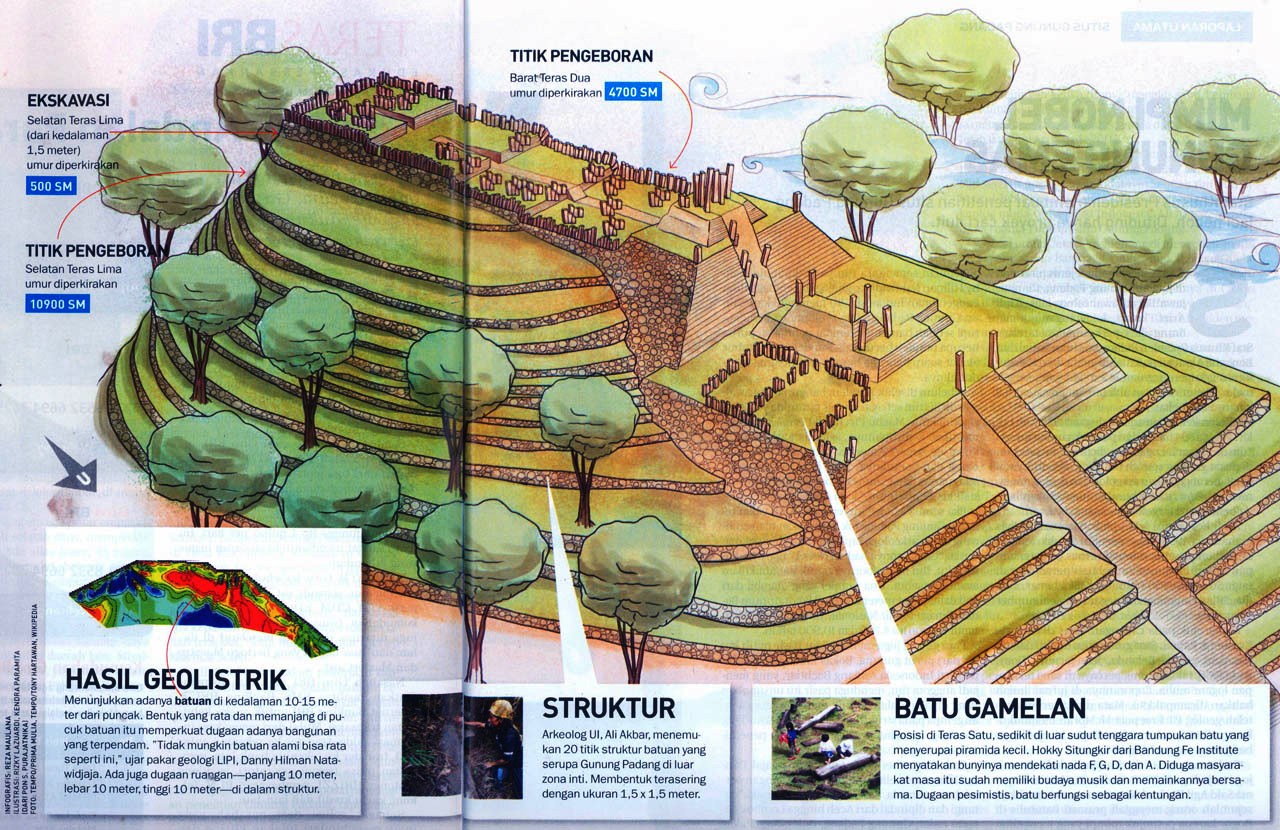 |
Four views of Gunung Padang. Top left, the main megalithic structure on the summit (courtesy of Wiki Commons). Top right, slotting stones at the site. Bottom left, Google map showing the position of Gunung Padang. Bottom right, a tentative reconstruction of the entire complex, which could date back 9000-20,000 years.
In Graham’s words “Göbekli Tepe is a game changer. The Pandora's box of prehistory has been opened and the past will never look quite the same again".
Hear
Graham Hancock reveal his thoughts on Göbekli Tepe and its place in the origins
of civilization at the Origins 2013 Conference, Steiner House, London, on Saturday,
16th November.
For tickets and info click the Origins 2013 advert below:
This event is going to be mega - Graham Hancock re-booting the whole lost civilization paradigm, and every speaker revealing new revelations of our ancient past. I shall exclusively reveal who built Göbekli Tepe, where they came from, and why they did it.
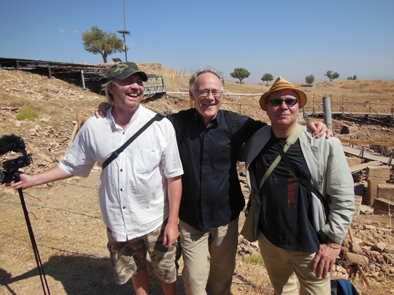
Hugh Newman, Graham Hancock and Andrew Collins enjoy a joke as they attempt to solve the mysteries of the universe at Göbekli Tepe on September 16th, 2013.
Don't miss out on the next Megalithomania Tours of Turkey scheduled for April 2014 and September 2014. Register your interest now with Andrew Collins or Megalithomania.co.uk
![]()
![]()

